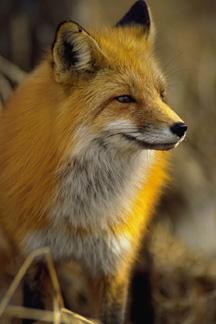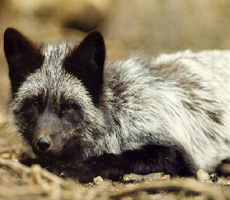
English Name: Red-Fox and color-mutants (Black fox, cross fox, silver fox. )

color mutant (Silver Fox):

Deutscher Name
-Rotfuchs und Farbmutationen (Silberfuchs, Platinfuchs, ...)
Group
-Vulpes (real foxes)
Lathin Name:
-Vulpes vulpes / Vulpes vulpes vulpes (the Northamerican population is called Vulpes fulfa)
-I've seen a Silver Fox (wrongly) called Canis vulpes (Canis lupus is the standart wolf) once.
-Silver Fox = Vulpes fulvus
appearance:
-Reddish orange fur, small dog sized; thick bushy tail in
winter (horizontal kept while running), Topside copperred, Ear-outsides and shanks brown-black,
Tailend and marking at the head white, downside whitish.
-Crossfox=white stripes across the Schoulders and lengthwise the
back
-Ice-foxes have Crossfoxes too
-Black Fox=a silver undercoat and black-tipped guard hairs
-Head/body length: average 67-75(80)cm for males; 62-67cm for females
(both between 18 and 37 inches)(Males are usually bigger than
females)
-Tail about 40cm(45) (half length of body) (between 12 and 23 inches/ 1-2 foot)
-Weight: average 6-7kg(9 to 12 pounds) for males; 5-6kg(9 to 10
pounds) for females
-about 30cm high
-usually reddish on back and face, white on underparts; tail
bushy, white tipped; black legs and feet
-The red phase is red colored above, whitish below. The silver
phase is almost completely black with silver tipped hairs, and
the cross phase is reddish brown with a dark cross on its
shoulders. All color phases of the red fox have a white tipped
tail.
-One study found that northern red foxes are darker and its
colors more intense than southern red foxes. For example, 70% of
the red foxes in British Columbia exhibit the black and cross
color phases. While in the Great Basin, further south, they make
up less than 20% or the population, the red phase being more
predominant.
-Gloger's Rule, a basic tenet of biology, states that birds and
mammals living in the northern hemisphere tend to have lighter
races living in the north and darker individuals in the south.
While the "rule" obviously doesn't fit red fox
populations, it is true most of the time.
-yellow, vertically slit eyes and a good night-vision (remarkable for a canine)
Geographic Range:
-Europe, North- and Middleasia, Northamerica,inducted to Australia .

Habitat:
-Tundra, Taiga, Woods, Parks and land developed and cultivated
by man till 1800m, in Tibet till 4000m.
-(in nearly all habitats from salt marshes and sand dunes to the
tops of mountains)
-adapted to life in urban surroundings
Behaviour:
-Day-,twilightactive.
-Foxes hold territories, the size of which depends on habitat;
0.2 square kilometres in urban areas or up to 40 square
kilometres in hill country.
-Each territory is occupied by a fox family group. These often
consist of a pair - dog fox and vixen - and their cubs. However,
in areas where foxes are not persecuted and where there is a
plentiful supply of food, a family group may contain several
adults.
- In urban areas cubs are often born under garden sheds.
- A vixen stays in the earth with her cubs for the first two weeks
of their lives.
-When they're about four weeks old, (usually late April or early May), cubs
start to come out into the open, where they are often seen by city
householders.
-Foxes often smell like they have been in a fight with a skunk,
but the smell is actually a result of a small scent gland located
beneath the tail near their anus. This skunk-like, sometimes
known as "foxy," smell is associated with the courtship
behavior of the red foxes. As one author has stated, "It is
my nose more than anything that first tells me when foxes are
courting," (Henry 1986).
-During courtship, a female and male red fox establish a
territory by "scent marking." This is achieved by
urinating on logs, rocks, and bushes, which in addition to the
anal gland, serves as a secondary source of the fox's unique
fragrance.
-The boundaries of this territory are characterized by the strong
"foxy" odor. Foxes also have a scent gland on their
tail, as do many canids, but the significance it plays
communication is unknown (Lloyd 1980; Henry 1986).
Reproduction
- Mating: Jan-Feb(March)
- birth after: 51-52 weeks
- birth-time: Mar.-Apr.
- litter size: 3-6 (normal: 4-5)(3-12)
- weaned after: 8-12 weeks
- grown up in: 10-11 month
- Usually only one vixen in a group produces cubs, once a year in
the spring.
- mostly survive only 1 or 2 years (up to 9(12) years in the wild)
(The average lifespan of red foxes is between three and four
years)
-hunting for rearing vixens not allowed between the 16.March and 15.June (not for dog-foxes)
Food Habits:
-very wide and varied diet.
-crabs, dead seabirds, carrion, small mammals, especially field
voles and rabbits, earthworms, beetles, fruit (particularly
blackberries) and small birds
-Urban foxes glean large amounts of food. supplemented by
scavenging from dustbins, birdtables and compost heaps. Unlike
rural foxes, those living in some urban areas eat many small
birds and feral pigeons.
-One study found that rabbits make up a larger proportion of its
diet in the winter than in the summer, when it eats mostly rats
and mice. Another study, in a different location, found that
animals in general made up the bulk of the red fox's winter diet
while insects and fruits were the summer preference. Besides
rabbits and mice, red foxes eat raccoons, skunks, young opossums,
squirrels, porcupines, songbirds, ducks, bird eggs, and a variety
of other animal species. Plant foods include grasses, nuts,
berries, fruits, corn, and wheat. They also eat carrion (Samuel
and Nelson 1982).
Specialities :
-3 more, close related kinds from western-asia across Tibet,
Nepal to Assam.
-about 10 related species in noth-west North-america
-The red fox can run up to 30 miles per hour and is able to jump
over barriers 6½ feet high (Nowak 1991).
others :
Links :
(dead link removed)
-